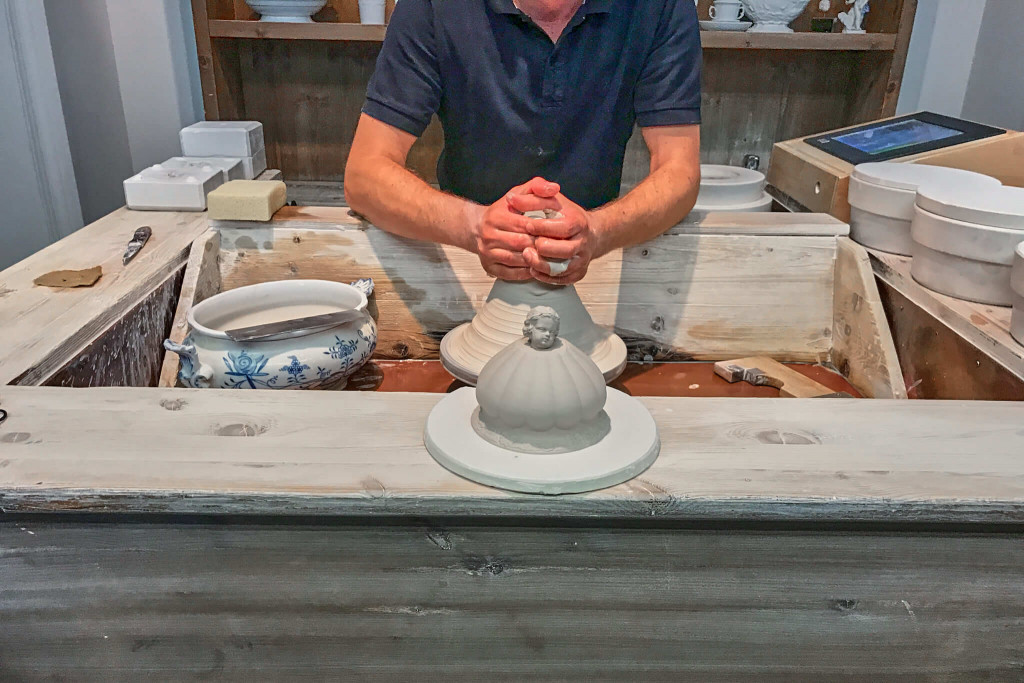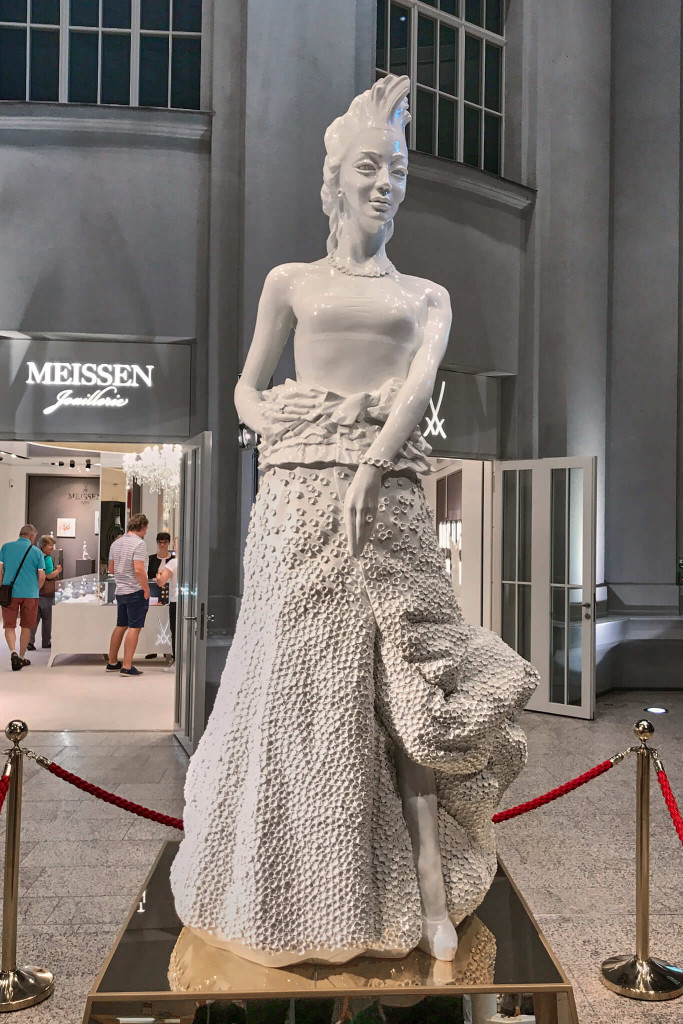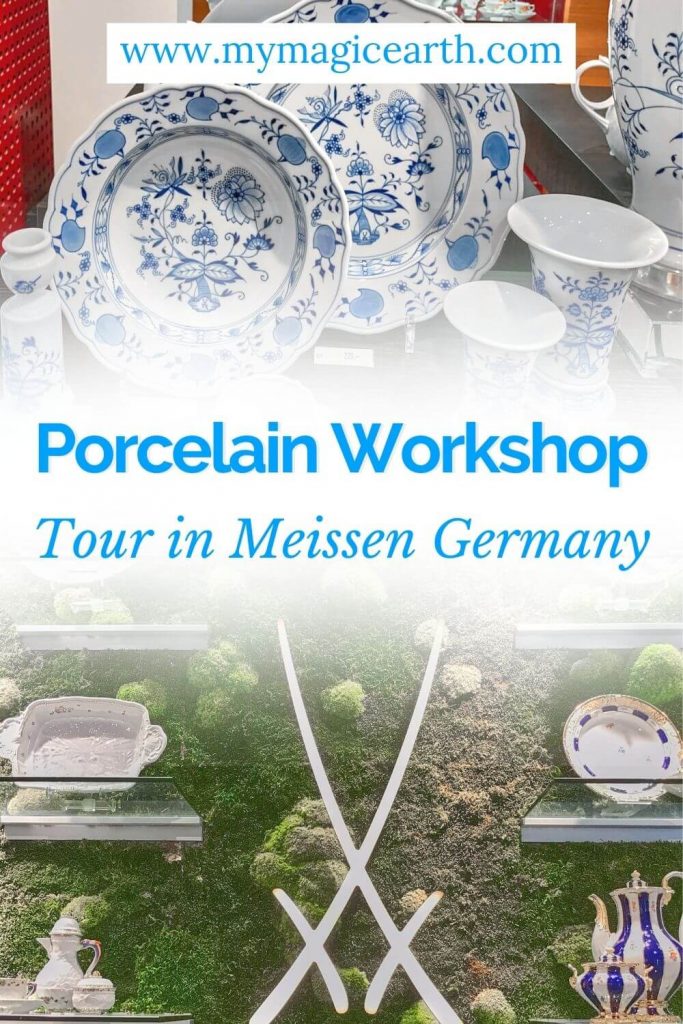Meissen porcelain, distinguished by the iconic blue crossed swords mark, is renowned for its quality, exquisite craftsmanship, and the ever-popular Blue Onion design. The rarity and popularity of antique porcelain have led to a significant surge in prices in recent years, making them highly coveted. Additionally, the cost of new products remains high due to traditional production methods.
As Meissen was included in my Dresden trip itinerary, I seamlessly combined the workshop tour with a visit to the city of Meissen.
A brief history of Meissen porcelain
Meissen Porcelain, considered the first European porcelain, originated in the early 18th century under the guidance of Ehrenfried Walther von Tschirnhaus. Augustus the Strong’s support led to the establishment of Europe’s inaugural porcelain manufactory within the Alberechtburg Castle.
Johann Friedrich Böttger, von Tschirnhaus’s successor, succeeded in crafting refined and exceptionally durable red stoneware after numerous experiments. Under the leadership of Johann Gregorius Höroldt, an overglaze painting technique was introduced. The distinctive underglaze “Meissen Blue” and the renowned Blue Onion design, introduced by Friedrich August Köttig, became bestsellers after the shift from the Asian decorative style in 1740.
Despite the challenges of World War II, production persisted until April 1945. A Soviet company took control of the factory on August 1st, 1946, but ownership was returned on July 1st, 1950. Since June 26, 1991, the factory has operated as the State Porcelain Manufactory Meissen GmbH, with the Free State of Saxony as its sole shareholder.


The crossed swords mark of the Meissen Porcelain
In the early period, the sign AR, denoting Augustus Rex and paying homage to Saxon Elector Friedrich August I, frequently seen on the products.
Later, the iconic blue crossed swords marked as a pivotal symbol. Alongside the swords, handwritten characters like K.P.M. (Royal Porcelain Manufactory) were also prevalent. However, the sword mark gained prominence following a written order from the electoral court in Dresden in 1731.
The crossed swords have become synonymous with Meissen Porcelain, though their appearance underwent subtle changes over the years. The trademarks “Böttgersteinzeug” and “Meissner Porzellan” were officially registered in 1919 and 1985.
Imitations of the trademark typically bear a vaguely similar mark, but the density and weight of the porcelain are equally crucial as they directly reflect its quality.


Experience the Meissen Workshop Tour
The workshop tour provided a firsthand look at the process behind crafting the renowned Meissen porcelain. In the first room, the potter skillfully demonstrated the creation of round-piece porcelain on spinning wheels, shaping each Meissen plate, cup, and vase by hand. The porcelain paste was turned until it achieved the desired form and was then gently pressed into a plaster mould.
Moving to the next room, the embosser showed us the transformation of a large component into a figurine or statue. Smaller decorative elements like leaves, flowers, and scallops were carefully handcrafted using a wooden mould and carefully attached to the figurine.




Following the first firing, the porcelain attained the necessary hardness for underglaze painting. In the third room, the painter applied the cobalt blue colour to a plate. All glazes and underglaze paints are prepared in-house at the Meissen manufactory.
Finally, in the last room, an artisan showcased on-glaze painting. Colours were applied by hand to the glazed porcelain. Using a mixture of coloured powder and turpentine, the artisan created the paint and skillfully applied it to the porcelain. Mastering this technique requires expert skills, as even a small error can render the porcelain piece unusable.
Admire the Museum of the Meissen Porcelain Foundation
Built in 1916 in the style of a Neoclassical banquet hall, the porcelain museum displayed 300 years of porcelain history arranged chronologically from 1710 to the present. The permanent exhibition featured a diverse collection of porcelain pieces crafted with different materials and techniques across various years.
Among the notable exhibits were porcelain pipes, with a fascinating backstory. In 1950, porcelain designer Ludwig Zepner discovered some relics of discontinued experiments by Kaendler in 1730 and Boemer in 1920 in the manufactory’s loft. Both had attempted to create porcelain pipes. Through a series of challenging experiments, Zepner mastered techniques to prevent deformation, resulting in a globally unique invention.
One feature I discovered was Meissen’s overglaze colour palette, showcasing a myriad of colours unique to Meissen. QR codes on many displays provided additional historical insights, all conveniently available in English. For young visitors, a treasure hunt rally added an interactive element to their museum experience, with a small round piece of porcelain bearing the authentic crossed swords as a souvenir.



Saxon Statue of Liberty (Die Sächisische Freiheisstatue)
In front of the museum, the Saxon Statue of Liberty is on display. Created on the occasion of the 25th anniversary of German reunification, it is the largest freestanding porcelain sculpture in the world currently. Titled Saxonia, a life-size elegant female is in a dress made from 8,000 single handmade Meissen porcelain blossoms. The sculpture bears witness to the craftsmanship and artistry of the porcelain production at Meissen.
Recent art from the middle east
The current temporary exhibition displayed the latest artworks from the Middle East, offering a glimpse into the delicate balance between modernity and tradition in porcelain style. There’s a rising interest in Middle Eastern and Iranian art, reflecting a trend that has steadily gained momentum in recent years.
Other important porcelain museums
Two locations outside the factory premises also displayed significant pieces. The southern arcade galleries of the Dresden Zwinger hold the most crucial collection of historic Meissen porcelain, comprising over 1,400 objects. Additionally, the Rijksmuseum Amsterdam houses the most important collection of Meissen porcelain outside of Germany.
Seek Meissen Boutique in the Outlet
On-site, there’s a Meissen porcelain outlet offering tableware, cups, single figurines, and more. The prices here were quite budget-friendly. For the latest porcelain products, you can check out the shop adjacent to the outlet, where prices tend to be higher.
Relax at the Restaurant & Café
After hours of being attracted by the stunning porcelain pieces, hunger and thirst had caught up with us. We decided to order cakes and a plate of salad elegantly presented on Meissen porcelain. The Meissen Torte (cake in English) even featured Meissen’s iconic Crossed Swords.
My tips and recommendations
The tour was very popular, and I found myself patiently waiting for an hour to experience it. It’s worth noting that visitors were not allowed to carry large bags, such as rucksacks, inside the factory premises. Fortunately, there’s a designated area where you could safely deposit your bags.
The tour itself included an audio-guided exploration through the demonstration workshops, available in 14 languages. Additionally, it included a single visit to the Museum of the Meissen Porcelain Foundation. It’s advisable to secure your ticket to the Meissen Porcelain Factory online.
Situated not far from the Albrechtburg Castle, which served as the manufactory of Meissen porcelain for 173 years, the factory’s proximity makes it a worthwhile visit as well.
How to get there
Address
Staatliche Porzellan-Manufaktur Meissen GmbH
Erlebniswelt HAUS MEISSEN®
Talstraße 9
01662 Meißen
Germany
Directions
- The S-Bahn (S1) from Meissen Altstadt (Meissen old town) provides a direct route to the factory, with just one stop. Once you exit the S-Bahn, it’s approximately 600 meters to reach the factory.
- For those choosing to walk from Meissen Altstadt, the distance is approximately 2 km, and the stroll takes around 23 minutes to reach the factory.




Can wait to visit ; I’m from Chile my grandmother was German and We admire the great nation of Germany
I am always so impressed to see this kind if thing, I can totally see why you liked it all. Did you end up buying something to bring home?
It’s awesome to see the artists paint on that famous cobalt blue. I didn’t expect it to look so grey before it is fired.
Hi Josy,
Thanks for the comments! I liked several sets but I couldn’t afford them. Some pieces are the single ones. So if someone is just looking for a replacement, that’s a good deal since such pieces are really affordable.